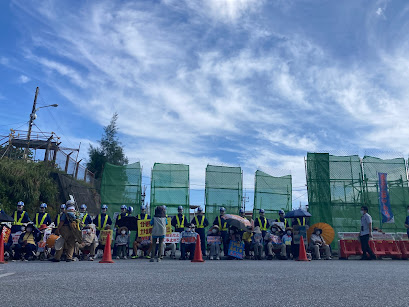Public Comments on the EIA Scoping Document: Mage Shima SDF Base
Mage Shima Base Construction and EIA
On April 1, 2021, the Okinawa Environmental Justice Project submitted its public comments on the Scoping Document, part of the Japanese Ministry of Defense's Environmental Impact Assessment (EIA) for its plan to construct a Self-Defense Forces (SDF) airbase on Mage Shima, Kagoshima.
We are glad that OEJP joined other environmental groups, environmentalists, and concerned citizens in submitting public comments. We thank Mr. Shin-ichi Hanawa (formerly with WWF-Japan) and the Okinawa Environment Network for allowing us to share and post their comments on this blog page. (We can learn a lot from their expert comments)
 |
| Mage Shima and Tanega Shima (in the back) Image Source: Nishinippon Shimbun News |
Expansion of SDF Bases in the Nansei (Southeast) Islands Chain
Over the last decade, the Japanese Ministry of Defense has feverishly expanded its footprints and capabilities in the Nansei islands chain against China's and North Korea's threats. Yonagumi, Miyako, Ishigaki, and Okinawa island of Okinawa and Amami-Oshima island of Kagoshima have seen new SDF bases and facilities being built on their islands. The Mage Shima base plan is the latest component of the Defense Ministry's expansion.
Given that many of these islands are small in size and rich in environmental values (Amami-Oshima has been nominated for UNESCO's World Natural Heritage), the expansion has raised alarming concern about their various impacts on the local environments and communities.
EIA as Rubber-Stamp for Environmental Destruction
In an ideal world, the EIA process should provide science-based safeguards for the environment and communities to be impacted in implementing a plan (See this site for the Japanese EIA). The Scoping Document should outline the extent of the plan and the elements to be assessed.
In an ideal world, the EIA process should provide science-based safeguards for the environment and communities to be impacted in implementing a plan (See this site for the Japanese EIA). The Scoping Document should outline the extent of the plan and the elements to be assessed.
However, in Japan, the opposite has been the case with many projects. The most telling example is the EIA process taken by the Defense Ministry for the Henoko base project in Okinawa: the Ministry's EIA was anything but a government rubber-stamp for the base construction and the destruction of the environment.
The Japanese government insists that since the Henoko project went through the EIA process (and the land reclamation approval process), the project is legal. And this has enabled the government to ignore the overwhelming democratic voice of the Okinawan public against the Henoko project. (Does it sounds like what happens in a non-democratic country). Also, it has allowed the Japanese government to make absurd claims that the environmental damages occurring in the construction area are not related to the base construction. (See this Okinawa Prefectural Government's document debuting the Japanese government's "no-impact-on-the dugong" claims).
We don't want to see this happen to Mage Shima and Tanega Shima and their neighboring islands.
OEJP's Comments on the Scoping Document
In the OEJP Public comments, bringing in our experience with the Henoko project, we pointed out several critical issues and made suggestions for improvement. For example, we addressed the inadequacy of information on the proposed military training and methods for measuring impacts from it, and we called for more detailed information on them and broadening the areas for EIA. We also pointed to the lack of discussion on "alternatives" to the current plan and called for the inclusion of the word "alternatives" into the EIA process.
In the OEJP Public comments, bringing in our experience with the Henoko project, we pointed out several critical issues and made suggestions for improvement. For example, we addressed the inadequacy of information on the proposed military training and methods for measuring impacts from it, and we called for more detailed information on them and broadening the areas for EIA. We also pointed to the lack of discussion on "alternatives" to the current plan and called for the inclusion of the word "alternatives" into the EIA process.
As a more fundamental point, we argued that the current Japanese EIA is not designed to assess the impacts of military facilities and training on the environment and communities and called for establishing a specific EIA system for them before the defense ministry moves forward with the base plan.
 |
| Proposed Military Training on and around Mage Shima Image Source: the Scooping Document |
We at OEJP believe that civil society's engagement in the EIA process is crucial in revealing issues of each project and exposing the inadequacy of the present EIA system.
See:
Okinawa Environment Network's Public Comments (in Japanese)


